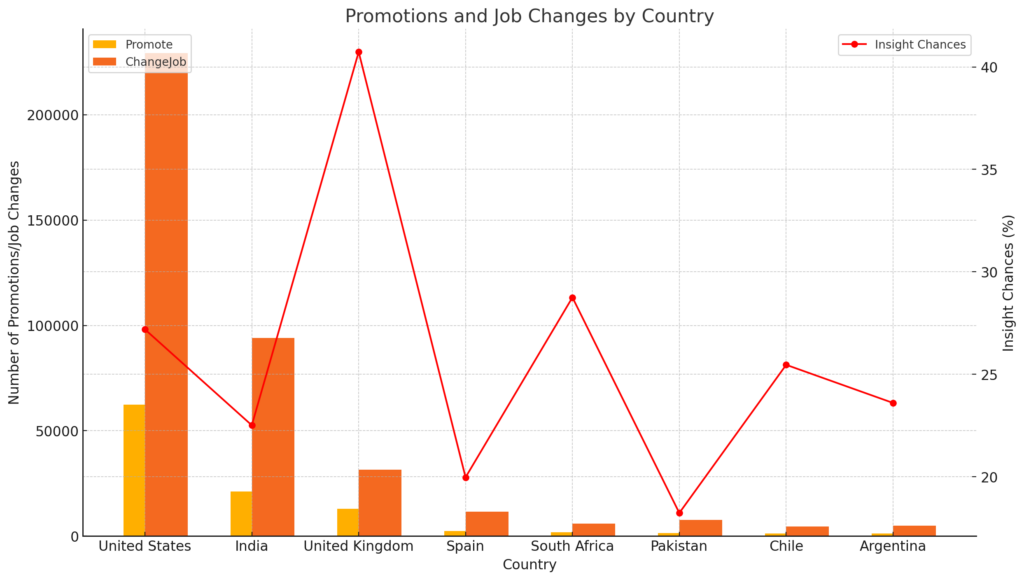Job Market Trends: A Comprehensive Insight of May 2024
In an era defined by rapid technological advancements and shifting economic landscapes, understanding the dynamics of job markets across various countries is crucial for businesses and policymakers. A recent analysis of LinkedIn data from May 2024 provides a revealing glimpse into global employment trends, highlighting key patterns in job changes and promotions across eight countries. Here’s a detailed look into the data and what it signifies for companies.

High Mobility in the US
The United States leads significantly in both promotions and job changes, with 62,360 promotions and 229,331 job changes. The insight chances, calculated at 27.19%, indicate a highly dynamic job market where employees frequently move up within their current companies or switch jobs. The high mobility reflects a robust job market where opportunities for career advancement and new roles are plentiful.
Insight: This trend underscores the importance of tools that can track and predict employee movement, aiding companies in talent acquisition and retention strategies. Companies can leverage this dynamic to develop more sophisticated analytics for workforce trends and target key decision-makers during their job transitions.
Significant Job Changes in India
India also shows a substantial number of job changes (94,029) and promotions (21,168). The insight chances, at 22.51%, suggest a competitive job market, possibly driven by the tech and services sectors. The disparity between job changes and promotions highlights the competitive nature of India’s employment landscape, where employees might find better opportunities by switching jobs rather than climbing the corporate ladder within their current organizations.
Insight: Companies targeting the Indian market should focus on competitive intelligence tools that highlight emerging job trends and provide insights into employee movement across sectors. This can help businesses stay ahead in talent acquisition and market positioning.
Promotions vs. Job Changes
The “Insight Chances” column, representing the ratio of job changes to promotions, offers a deeper understanding of internal mobility versus external job changes.
- United Kingdom: With a ratio of 40.73, the UK has a much higher rate of promotions compared to job changes, possibly indicating stronger internal career progression pathways.
- South Africa: An Insight Chances ratio of 28.75 suggests a balance but still leans towards more job changes compared to promotions.
Insight: For companies operating in these regions, understanding these ratios can help in developing better employee retention programs and career development initiatives. Higher job change rates might necessitate stronger internal mobility frameworks to retain talent.

Lower Numbers in Spain, South Africa, and Latin American Countries
Countries like Spain, South Africa, Chile, and Argentina have much lower numbers overall. This could reflect smaller LinkedIn user bases or less dynamic job markets.
Insight: These regions may benefit from improved professional networking platforms and career development services. Companies could invest in local job market analysis tools to better understand the underlying causes and address the gaps in employment dynamics.
Promotion Rates
The actual promotion numbers are quite telling. The US and India lead in promotions, hinting at robust internal career development programs or perhaps a culture that emphasizes climbing the corporate ladder. Conversely, Spain, South Africa, Pakistan, Chile, and Argentina have relatively fewer promotions, which could point to different career progression dynamics or structural issues in these economies.
Insight: For companies, targeting professionals in regions with high promotion rates might yield better engagement. Developing tailored solutions that cater to the unique career progression challenges in regions with lower promotion rates is crucial.
Comparative Analysis
Despite having lower absolute numbers than the US and India, the UK’s high ratio (40.73) might indicate a preference or need for changing jobs to progress in one’s career rather than being promoted internally.
Insight: This highlights the importance of flexible career paths and robust external job market insights for companies in the UK. Data firms can provide valuable services by analyzing these trends and offering strategic advice to businesses.
Conclusion
Understanding these patterns is crucial for businesses and policymakers to tailor strategies for employee engagement, retention, and overall economic planning. As job markets continue to evolve, leveraging detailed insights from data will be key to staying ahead in the competitive landscape. These trends provide a roadmap to refine offerings and strategies in alignment with the dynamic employment environment.
Feel free to reach out for deeper analysis or further insights into these trends!

